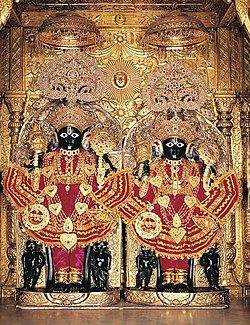Nara-Narayana
| Nara Narayana | |
|---|---|
 The twin form of NarNarayan Dev at the Swaminarayan Temple Ahmedabad | |
| Devanagari | नर-नारायण |
| Sanskrit Transliteration | nara-nārāyaṇa |
| Affiliation | Avatar of Vishnu |
| Abode | Badrinath |
Nara-Narayana (Sanskrit: नर-नारायण; nara-nārāyaṇa) is a Hindu deity pair. Nara-Narayana is the twin-brother incarnation of the preserver-god Vishnu on earth, working for the preservation of dharma or righteousness. In the concept of Nara-Narayana, the human soul Nara is the eternal companion of the Divine Narayana.
The Hindu epic Mahabharata identifies god Krishna with Narayana and Arjuna - the chief hero of the epic - with Nara. The legend of Nara-Narayana is also told in the scripture Bhagavata Purana. Hindus believe that the pair dwells at Badrinath, where their most important temple stands.
The Nara-Narayana pair is frequently worshipped in temples of the Swaminarayan Faith. The followers of the sect believe that their founder Swaminarayan is an incarnation of Narayana.
Etymology

The name "Nara-Narayana" can be broken into two Sanskrit terms, nara and Narayana. Nara means human, and Narayana refers to the deity of the name.
Monier-Williams dictionary says Nara is "the primeval Man or eternal Spirit pervading the universe (always associated with Narayana, "son of the primeval man"; both are considered either as gods or sages and accordingly called देवौ, ऋषी , तापसौ. In epic poetry, they are the sons of Dharma by Murti or Ahimsa and emanations of Vishnu, Arjuna being identified with Nara, and Krishna with Narayana.- Mahabharata, Harivamsa and Purana".[1]Narayana is Vishnu while Nara is Shesha
Depiction
Nara-Narayana are depicted jointly or separately in images. When depicted separately, Nara is portrayed with two hands and wearing deer skin while Narayana is shown on the right in the usual form of Vishnu.
Sometimes, both of them are depicted identical to each other. They are depicted four-armed holding a mace, a discus, a conch and a lotus, resembling Vishnu.


No comments:
Post a Comment